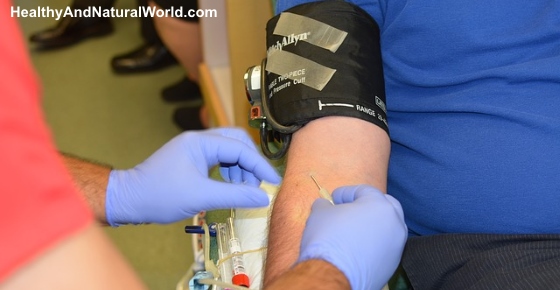Most Doctors Won’t Tell You, But This Can Cut Heart Attack & Stroke Risk By 80%

Most people know they can save the lives of others by donating blood, but this somehow still does not motivate them to take the time out of their busy lives to donate. What very few people know is that they can also save their own lives by donating blood, which may just serve as a strong motivating factor to do so.
How to Reduce Your Risk of Heart Attack and Stroke – The Research
In 1997, researchers at the University of Kansas published a study with 3,855 participants that compared blood donors and non-donors on several vascular events like heart attack, stroke, angioplasty, bypass surgery, and nitroglycerin use.
They found that only 9.77% of male blood donors suffered from such events, while an alarming 17.72% of non-donors did.(1) In other words, non-donors were 81% more likely to suffer from cardiovascular events than donors.
In 1998, researchers published the result of an evaluation of the records of the Kuopio Ischaemic Heart Disease Risk Factor Study which followed 2,862 Finnish men aged 42-60 years for almost nine years.
After comparing the occurrence of heart attack in blood donors and non-donors, they found that blood donors reduced their risk of heart attack by 88%.(2) This percentage is roughly similar to that in the previous study. Female donors, however, were hardly at all heart healthier than female non-donors.
Why Blood Donation Reduces Heart Attack Risk
At this stage researchers are not sure why between 80 and 90% fewer blood donors suffer cardiac events than non-donors, but the fact that it applies only to men lends itself to some hypotheses.
Iron Levels, Cholesterol and Atherosclerosis
Atherosclerosis is a condition of the arteries that is characterized by the deposition of fatty material on their inner walls. Medical experts have long hypothesized that stored iron in the body promotes the oxidation of cholesterol, the occurrence of which seems to be involved in atherosclerosis.
In fact, studies have found that even people with a high dietary intake of iron are more likely to suffer cardiovascular events because of this.(3) The body stores instead of excreting it, which increases the likelihood that cholesterol will be deposited on artery walls.
Monthly menstruation ensures that women store less iron than men, which may explain why pre-menopausal women are less likely to suffer from atherosclerosis than men.(4) By donating blood, men can shed some of their iron stores and thereby lower their risk of atherosclerosis.
The Blood of Regular Blood Donors is Thinner than that of Non-Donors
Thrombosis is the coagulation or clotting of the blood in a part of the circulatory system. If this solid or semi-solid blood moves through thinner arteries (such as those in the brain), it may block them and prevent blood from moving through to their intended locations. This cut-off in blood supply is one of the causes of both a heart attack and stroke (get familiar with these 10 signs of heart attack and these early signs of stroke).
Researchers have discovered that the blood of regular blood donors is thinner than that of non-donors and that the likelihood of thrombosis is smaller.(5) On the other hand, the viscosity of the blood of non-donors makes them not only good candidates for thrombosis, but also for high blood pressure due to the increased effort by the heart to move such a thick substance around the body.
The explanation lies in the difference between old and young blood cells. Researchers already know that old red blood cells are thicker and stickier than young red blood cells,(6) which explains why the new blood produced by blood donors’ bodies is thinner.
This is also why women are at smaller risk of thrombosis;(7) menstruation discards sticky old red blood cells that are more likely to coagulate. If men want to lower their risk of coagulating blood cells, they can force their bodies to replace old cells with new ones by donating blood.
Medical Examinations and Blood Donation
Before donating blood, all potential donors are subjected to basic medical examinations that may pick up signs of high cholesterol and high blood pressure. It is, therefore, possible that blood donors are heart healthier than non-donors because they are forced to undergo regular medical checks.
This does not explain why blood donation lowers the risk for only male donors, so it is certainly not the whole explanation. Moreover, there is no guarantee that potential donors with high cholesterol and blood pressure will visit a physician or make the required lifestyle changes.
Still, it may contribute to the findings; the studies certainly did not investigate whether or not potential donors with troubling medical checks made work of it later, so it cannot be ruled out.
Causation or Correlation
The authors of the above studies tentatively assumed that their results showed that blood donation caused in lowering of the risk for cardiovascular events. But what if the people at low risk of such events were more likely to donate blood than those at high risk?
In that case, blood donors are not heart healthier because of donating blood, the population of blood donors are heart healthier because blood donation is more appealing to them than to heart unhealthy people. In that case, blood donation and heart health are correlated, not causally related.
This is not impossible. Unhealthy people may be too afraid of medical procedures to donate, or may simply feel too ill after donating to make it a regular practice. Still, if the researchers are right that male donors benefit more from their donation than female donors, it seems more likely that blood donation causes heart health.
To clear this up, future research needs to ensure that the sample of blood donors is representative of the general population, instead of coming from the heart healthy cohort.
Related articles:
Medical Sources
